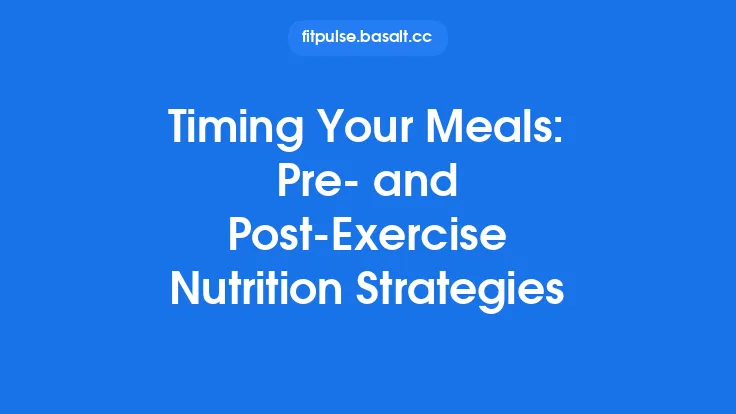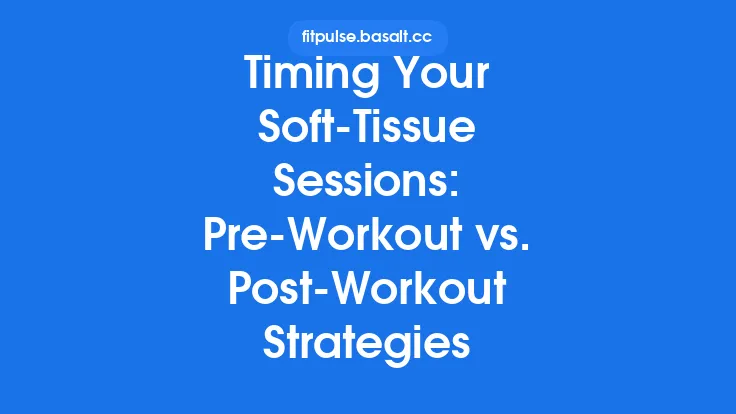When it comes to building strength, the work you do in the gym is only half of the equation. What you eat—and, just as importantly, when you eat it—can dramatically influence how much weight you can lift, how quickly you recover, and how consistently you make progress over weeks and months. By aligning your meals with the physiological demands of a strength‑training session, you give your muscles the fuel they need to perform, the building blocks they need to repair, and the hormonal environment they need to grow stronger. This article walks you through the science and practicalities of pre‑ and post‑workout nutrition specifically for strength athletes, offering actionable guidelines you can apply regardless of your training schedule, experience level, or dietary preferences.
Why Meal Timing Matters for Strength Training
- Energy Availability – Heavy compound lifts (squat, deadlift, bench press) rely on phosphocreatine stores and glycogen to generate the rapid bursts of force required for each rep. Consuming a meal that supplies readily oxidizable carbohydrates and a modest amount of protein within a few hours before training helps replenish these stores, ensuring you can lift with maximal power.
- Muscle Protein Synthesis (MPS) Window – Resistance exercise sensitizes muscle tissue to amino acids, amplifying the MPS response for roughly 24–48 hours after a session. Providing high‑quality protein soon after training capitalizes on this heightened sensitivity, shifting the net balance toward muscle accretion rather than breakdown.
- Hormonal Modulation – Nutrient intake influences insulin, cortisol, and growth hormone dynamics. A well‑timed carbohydrate‑protein meal can blunt the post‑exercise cortisol surge and promote an insulin environment that drives nutrients into muscle cells, supporting recovery and growth.
- Practical Consistency – Establishing a predictable eating schedule reduces the likelihood of missed meals, erratic blood‑sugar swings, and the temptation to rely on low‑quality “quick fixes.” Consistency is a cornerstone of long‑term strength gains.
Pre‑Workout Nutrition: Primary Goals
| Goal | Why It Matters |
|---|
| Provide Immediate Energy | Carbohydrates raise blood glucose and muscle glycogen, supporting high‑intensity lifts. |
| Supply Amino Acids | A modest protein dose begins the MPS cascade before the workout, limiting catabolism. |
| Optimize Digestion | Choosing easily digestible foods prevents gastrointestinal discomfort that can impair performance. |
| Maintain Hydration | While not a focus of this article, adequate fluid intake is essential for muscle function. |
Ideal Pre‑Workout Meal Composition
| Component | Recommended Amount | Timing Relative to Training |
|---|
| Carbohydrates | 0.5–1 g per kg body weight | 2–3 hours before the session (larger meals) or 30–60 minutes (lighter snacks) |
| Protein | 15–25 g of high‑quality protein | Same window as carbs; a whey, soy, or plant‑based isolate works well |
| Fat | ≤ 10 g (keep low) | Include only if the meal is > 2 hours away; fats slow gastric emptying |
| Fiber | ≤ 5 g (if < 2 hours) | Keep low to avoid bloating; higher fiber is fine for meals > 2 hours out |
Note: The exact gram amounts can be adjusted based on individual tolerance, training intensity, and personal schedule. The key is to provide enough carbohydrate to top off glycogen without causing a heavy, sluggish feeling.
Sample Pre‑Workout Meals
| Timing | Meal | Approx. Nutrient Breakdown |
|---|
| 2–3 h before | 1 cup cooked oatmeal, 1 scoop whey protein, 1 banana, 1 tbsp almond butter | ~60 g carbs, 25 g protein, 10 g fat |
| 1 h before | Greek yogurt (200 g) with ½ cup berries and a drizzle of honey | ~30 g carbs, 20 g protein, 2 g fat |
| 30 min before | 1 medium apple + 1 oz (≈28 g) whey isolate mixed with water | ~25 g carbs, 20 g protein, negligible fat |
| During a fasted session | Optional: 5 g creatine monohydrate (non‑caloric) + water | No macronutrients, but supports phosphocreatine resynthesis |
Post‑Workout Nutrition: Primary Goals
| Goal | Why It Matters |
|---|
| Replenish Glycogen | Carbohydrates restore the depleted stores used during heavy lifts, preparing you for the next session. |
| Stimulate Muscle Protein Synthesis | A rapid influx of essential amino acids (especially leucine) maximizes the anabolic response. |
| Facilitate Recovery | Nutrients support repair of micro‑tears, reduce delayed‑onset muscle soreness (DOMS), and replenish electrolytes lost in sweat. |
| Support Immune Function | Adequate protein and carbohydrate intake post‑exercise helps maintain immune competence, which can be compromised by intense training. |
Ideal Post‑Workout Meal Composition
| Component | Recommended Amount | Timing Relative to Training |
|---|
| Protein | 20–40 g of high‑quality protein (≥ 2.5 g leucine) | Within 30–60 minutes post‑session |
| Carbohydrates | 0.8–1.2 g per kg body weight | Same window; higher if training multiple times per day |
| Fat | ≤ 15 g (optional) | Can be included; does not significantly impede MPS when protein and carbs are present |
| Electrolytes | Sodium, potassium (via food or a light sports drink) | Helpful if you sweat heavily or train in hot environments |
Sample Post‑Workout Meals
| Meal | Approx. Nutrient Breakdown |
|---|
| Shake (within 30 min): 1 scoop whey isolate, 1 cup frozen mixed berries, 1 tbsp honey, 250 ml skim milk | ~45 g carbs, 30 g protein, 5 g fat |
| Meal (1 h after): 150 g grilled chicken breast, 1 cup cooked quinoa, 1 cup steamed broccoli, 1 tbsp olive oil | ~50 g carbs, 35 g protein, 12 g fat |
| Vegetarian option: 200 g tempeh, 1 cup sweet potato mash, ½ cup black beans, 1 tbsp tahini | ~55 g carbs, 30 g protein, 15 g fat |
| Quick snack: 1 cup low‑fat cottage cheese + 1 tbsp maple syrup + a handful of grapes | ~30 g carbs, 20 g protein, 2 g fat |
Practical Tips for Scheduling Meals Around Training
- Plan Backwards from Your Session – Identify the exact start time of your workout, then slot a pre‑workout meal 2–3 hours earlier. If that window isn’t feasible, use a smaller snack 30–60 minutes before.
- Batch‑Cook Carbohydrate Sources – Cook a large batch of rice, quinoa, or sweet potatoes on a rest day. Portion them out for quick post‑workout meals, reducing decision fatigue.
- Use Portable Protein – Whey isolate, plant‑based isolates, or ready‑to‑drink protein beverages are ideal for athletes who train at the gym, office, or outdoors and need a fast, low‑volume source.
- Mind the “Window” Flexibility – While the classic 30‑minute post‑exercise window is useful, research shows that the anabolic response remains elevated for up to 2 hours. If you can’t eat immediately, aim to finish your meal within that broader timeframe.
- Adjust for Training Frequency – If you train multiple times per day, repeat the pre‑ and post‑nutrition pattern for each session, ensuring total daily carbohydrate and protein intake meets your overall needs.
Digestion and Absorption Considerations
| Factor | Impact on Timing | Practical Adjustment |
|---|
| Meal Size | Large meals (> 800 kcal) delay gastric emptying, potentially causing discomfort during lifts. | Keep pre‑workout meals moderate; reserve larger meals for > 2 h before training. |
| Fiber Content | High fiber slows carbohydrate absorption, which can blunt the rapid glucose rise needed for immediate energy. | Limit fiber to ≤ 5 g in meals consumed < 2 h before training. |
| Fat Content | Fat slows gastric emptying and can lead to a feeling of heaviness. | Keep pre‑workout fat low; post‑workout fat can be higher without performance penalties. |
| Individual Tolerance | Some athletes experience GI distress with dairy or certain plant proteins. | Test alternatives (e.g., lactase‑free whey, pea protein) during low‑stakes sessions. |
| Hydration Status | Dehydration slows nutrient transport and can impair digestion. | Ensure you’re adequately hydrated throughout the day; sip water with meals. |
Special Situations
Early‑Morning Training
- Challenge: Limited time for a full meal; overnight fast may deplete glycogen.
- Solution: A small, fast‑digesting carbohydrate‑protein snack (e.g., a banana with 15 g whey) 30 minutes before the lift, followed by a more substantial breakfast within an hour after training.
Late‑Evening Training
- Challenge: Eating a large post‑workout meal may interfere with sleep.
- Solution: Prioritize protein and moderate carbs in a compact meal (e.g., Greek yogurt with honey and berries) and keep total calories modest. If total daily intake is high, distribute calories earlier in the day.
Fasted Training (e.g., after overnight fast)
- Challenge: Low glycogen may limit maximal strength output.
- Solution: If performance is a priority, consider a small carbohydrate‑protein “pre‑workout” drink (e.g., 20 g carbs + 10 g protein) to raise blood glucose without causing fullness. For athletes focusing on metabolic adaptations, training fasted can be purposeful, but a post‑workout protein‑carb meal remains essential.
Vegetarian / Vegan Athletes
- Challenge: Achieving a complete amino acid profile quickly.
- Solution: Combine plant‑based protein isolates (pea, rice) that together provide sufficient leucine. Pair with easily digestible carbs like fruit or rice for rapid glycogen replenishment.
Common Mistakes and How to Fix Them
| Mistake | Why It Undermines Progress | Fix |
|---|
| Skipping the Pre‑Workout Meal | Low glycogen → reduced lift volume and strength. | Schedule a small carb‑protein snack at least 30 min before training. |
| Eating a Heavy, High‑Fat Meal 1 h Before Lifts | Slowed digestion → stomach discomfort, reduced power output. | Shift the bulk of the meal to > 2 h pre‑workout; keep the 1‑hour window light. |
| Relying Solely on Protein Post‑Workout | Inadequate glycogen restoration → slower recovery, impaired subsequent sessions. | Add a carbohydrate source that supplies ~0.8 g/kg body weight. |
| Delaying Post‑Workout Nutrition > 2 h | Missed anabolic window → diminished MPS response. | Prepare a ready‑to‑drink shake or pre‑portion a meal to consume immediately after training. |
| Consistently Eating Low‑Leucine Protein | Leucine is the primary trigger for MPS; insufficient amounts blunt the response. | Choose whey, soy, or a plant blend with ≥ 2.5 g leucine per serving. |
| Neglecting Individual Digestive Tolerance | GI upset can derail a session and affect performance. | Test foods during low‑intensity days; keep a log of what works best. |
Putting It All Together: A Sample Day for a 80 kg Strength Athlete
| Time | Meal | Rationale |
|---|
| 06:30 | Small pre‑workout snack: 1 banana + 15 g whey isolate mixed with water | Provides ~25 g carbs + 15 g protein 30 min before lift. |
| 07:00 | Strength session (90 min) | Peak energy from pre‑workout nutrients. |
| 08:15 | Post‑workout shake: 30 g whey isolate, 40 g dextrose, 250 ml low‑fat milk | Rapid delivery of ~45 g carbs + 30 g protein within 30 min. |
| 10:30 | Breakfast: 3 eggs, 2 slices whole‑grain toast, 1 cup mixed fruit | Balanced meal to sustain energy and provide additional protein. |
| 13:00 | Lunch: 150 g grilled salmon, 1 cup quinoa, 1 cup roasted vegetables, 1 tbsp olive oil | Moderate carbs + high‑quality protein for continued recovery. |
| 16:00 | Pre‑afternoon snack (if another session): 1 cup Greek yogurt + ½ cup berries | Light carb‑protein combo 60 min before optional accessory work. |
| 18:30 | Dinner (post‑second session or end of day): 200 g lean beef, 1 cup sweet potato, 1 cup steamed broccoli | Replenishes glycogen and supplies ample protein for overnight MPS. |
| 21:30 | Optional bedtime snack: 200 g cottage cheese + 1 tbsp honey | Slow‑digesting casein‑rich protein to sustain amino acid delivery overnight. |
Bottom Line
Strategically timing your meals around strength‑training sessions is a powerful, evidence‑based lever you can pull to enhance performance, accelerate recovery, and promote consistent muscle growth. By delivering the right mix of carbohydrates and high‑quality protein at the optimal moments—2–3 hours before the lift for sustained energy, a smaller snack 30–60 minutes prior for a quick boost, and a protein‑carb‑rich meal within the first hour after training—you create a nutritional environment that maximizes muscle protein synthesis, restores glycogen, and supports the hormonal milieu needed for strength gains. Adjust the specifics to fit your schedule, dietary preferences, and individual tolerance, and you’ll find that the synergy between your plate and your barbell becomes a cornerstone of long‑term progress.





